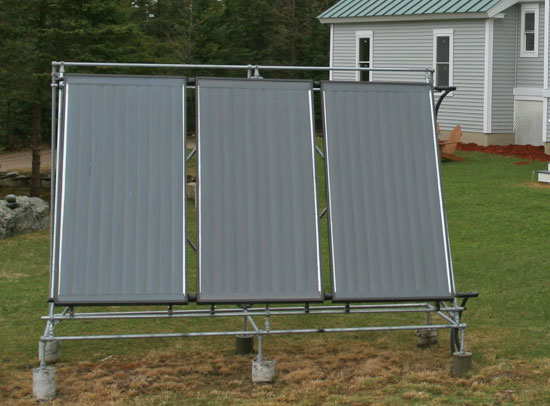
UPDATED: 1/3/11 with expert opinions from Mark Sevier and Peter Yost
Chris Koehn will be building a 1,600-sq.-ft. home in British Columbia for owners who want to heat primarily with wood. They envision a wood-burning cookstove and a fireplace, and they’d also like to incorporate some solar capability.
Because of its island location, the house will be off the electricity grid.
Among their concerns is that some parts of their house, including the bathroom and an upstairs bedroom, may be too far from a heat source to be comfortable. Koehn is considering heating the tile floors in the bathroom, but he’s concerned with how much electricity it would take to run the pumps.
There’s also the question of what to use as a source of backup heat to keep the house from freezing in winter, as well as help it meet local building codes.
“I’m looking for potential solutions from folks who have faced similar challenges,” he says in a Q&A post. The replies are the subject of this week’s Q&A Spotlight.
Keep it simple
Simple mechanical systems are best, suggests GBA senior editor Martin Holladay, who has lived off-grid for 35 years.
“Anyone who chooses to live off-grid should be willing to be flexible about indoor air temperatures in remote rooms on the coldest days of the year,” he says. “You can minimize these temperature differences, however, by paying scrupulous attention to air sealing and by providing very high levels of insulation in your floors, walls, and ceilings.”
Unlike grid-connected homes, which can always draw on utility electricity as required, an off-grid house must be completely self-sufficient. Electricity, whether it’s generated by a wind turbine, a photovoltaic array, or a fuel-fired generator, is precious.
“Whatever you do,” Holladay tells him,…
Weekly Newsletter
Get building science and energy efficiency advice, plus special offers, in your inbox.

This article is only available to GBA Prime Members
Sign up for a free trial and get instant access to this article as well as GBA’s complete library of premium articles and construction details.
Start Free TrialAlready a member? Log in





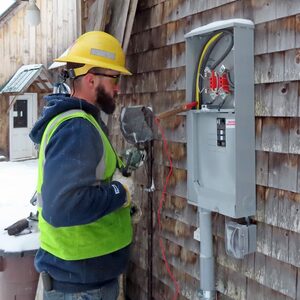
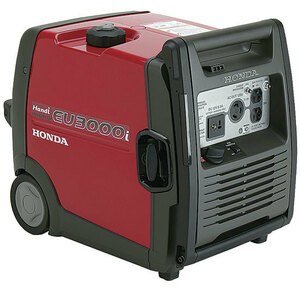
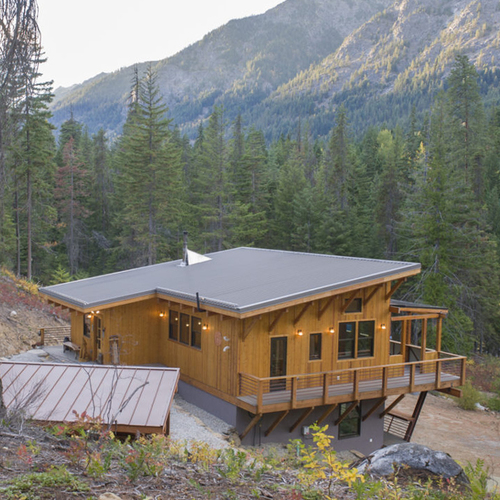
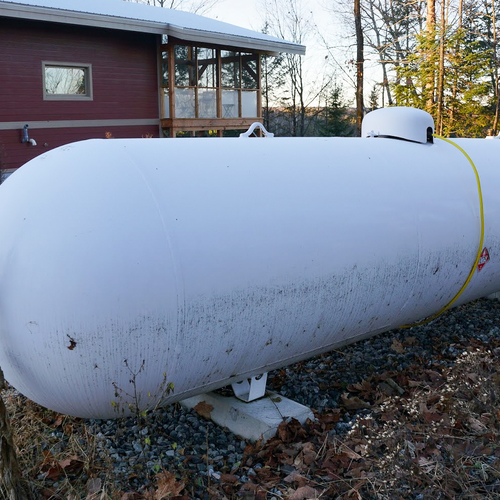






17 Comments
well insulated enclosure (R-25 to 35)
"well insulated enclosure (R-25 to 35)" We have to stop talking like this. Too much is missing to know what this means. IE... "pigs can fly" I suppose if they are in a plane... or for some being tossed in the air, that they are flying.
What you really are saying is, the whole assembly R value should be R-15 to 20 with no more than code approved air exchanges for the amount of air leaks?
I can build with continuous sheets of very well sealed foam sheeting to R-25 ala http://www.aaepassivesolar.com/ like Bruce Brownell has done for decades and I can build a 16" on center wall filled with take your pick of whatever and it will never perform close to the level of a Bruce Brownell home. Never. (and yet they both would be "well insulated enclosure (R-25 to 35)" wouldn't they) Don't trust me, then visit Bruce Brownell's homes in person. Then post here. I have and they definitely outperform many other styles of insulating to the SAME STATED R VALUE.
Stating R value is misleading and uninformative with out filling in the facts of the actual building assemblies and air leakages etc.
I think we have to stop the "easy talk" of throwing around higher R numbers in articles and posts. Nothing can be learned from it. Nothing. Actually what is learned is the masses are fooled into buying R values that are NOT BACKED UP BY HIGH ASSEMBLY VALUES AND THUS LOW ENERGY NEEDS WHICH IS THE INTENT OF THE WRITERS AND THE READERS BOTH!
WHY CAN'T I GET MY POINT ACROSS WITH OUT TYPING IN CAPS AND POSTING SUCH FOR MORE THAN A YEAR????
"well insulated enclosure (R-25 to 35)" is too subjective and completely misleading.
Response to AJ.
AJ, there are many things in the world that are worth arguing about.
I don't think this is one of them.
If guys like John Straube can effectively communicate in the archaic language of R values I don't see what the problem is.
Whole wall R values depend on the details of the assembly - and whether you want to talk in terms of R-value or Watts per square meter per degree K, you're still going to have to describe the details.
Response to AJ
AJ,
Providing all the specs of a building envelope takes a little time. Ideally, such a description would include, at a minimum:
- Blower door results (with a notation of the exterior surface area of the envelope);
- R-values of insulation (and a description of the insulation type) installed below the basement slab, at the basement walls, at the above-grade walls, and at the ceiling or roof;
- Window specifications;
- Some indication of passive solar features or orientation.
The more detailed the specs, the more interesting for the reader. But R-value matters, AJ, even though you don't want to read about. The last time you suggested that GBA stop providing R-value specs, I suggested that readers (like you) who don't care about R-values could simply ignore them. Other readers (myself included) are eager to read about R-values -- as well as airtightness details.
There is no need for you to lobby to deprive other readers of this information just because you don't want to read about it.
Martin, I love R Values that have a tad of meaning....
We are talking past each other it seems. Of course R values are interesting for most of us to read about including me. What I suggest is doable. Let's NOT take the easy route of simplistically stating R 25. Instead state Whole assembly R 25 (which could mean an insulation rated much higher depending on the complete build of your home.)
Let's start taking the baby steps to really informing when we pull out the "R" word in 2011.
John Straube does talk R my way, fantastically actually
Lucas... John and Joe are favorites of mine. I have been to Joe's seminars since he started doing them as a young pup. These guys can talk as scientists and as builders talk and think,,, and build.
R talk can be cheap talk.. lets raise the bar just a touch this year and next. Let's explain what R we are referencing. That would be a huge step in the informative direction. (just like the article you linked Lucas that is actually stating that net zero may best be reached soon with PV as a major part of one's design instead of Passive House specs. alone.)
A better way...
From the blog:
Before buying a gas powered wood-splitter, check to see if any of your neighbours already have one and devise a means of sharing it - if possible.
Better yet, check to see if any of your neighbours have a diesel tractor with a hydraulic take-off. A four-way hydraulic splitter that mounts on a 3 point hitch will split more wood, more efficiently (and with less noise) than a gas-powered splitter. Often, a good used hydraulic splitter is no more expensive than a new gas-powered unit.
Always keep a good 8lb splitting maul in your shed.
Masonary heater
Might want to check out the masonary heaters:
- Good efficiency, environmentally friendly.
- Heats radiantly several hours after the burn.
- Can be used for cooking.
- Some have heating coils.
Woodstoves
Friend of mine has a special woodstove that he is using to heat the water in the 2000 liter well insulated tank. He is heating the water up to 80 degrees. That stored heat he is using to heat the house with the hydronic floorheating and also for hot water needs. With normal winter weather (around minus 10 degree celcius) it will last for about 3 days with one heating.
This is very comfortable but he is not living of the grid.
Other friend of mine is heating his appartment with the slow burning fireplace. The fireplace is well sealed and almost everything is burned very slowly (hours and hours). That heat he does distribute with the pipes.
His appartment does heat up rapidly but the heat does last only until there is still something burning.
Many old houses in my country do have a masonary heater with a huge thermal store (tons of bricks). This is installed usually in the middle of the rooms (bigger houses do require several such fireplaces). With one heating it does keep the poorly insulated house warm at least a day .
This is quite convient solution in the remote locations but does require at least yearly maintenance (removing the lampblack). Problem is that it takes time for the rooms to heat up. Good thing is that there are still many oven builders who can build them from the scratch up (only special parts are the metal door and the valve to keep the final heat from escaping through the cimney).
Another option that is getting more popular in the Europe is fully automated wood burning using the pellets. Some pelletstoves even do integrate a Peltier element so you also generate electricity with them.
This is also very comfortable solution but the system is quite complex and you do require special maschine to create the pellets (this is usually done by distributor of course) so this is also not quite off the grid solution when you do not live in the community where it is more widely used.
What I would consider when planning an off the grid house would be a fireplace with the huge thermal store but also with the heat distribution with the pipes. I would also integrate water coil so I would get also hot water from it. I would connect it with separate heat tank. Smaller stove may be required to get the hot water when there is no need to heat up the big fireplace.
Proper insulation, air sealing and good windows are the must also. But then you also need a solution for the ventilation that is usually run by the elecricity but there are heat recovery systes that are operated by the wind.
Kris, Martin is right about keeping it simple when off grid
Water circulation is not simple, including large tanks of water is not simple, having the main heat source needing constant attending is not a good idea if not constantly home.
Martin and all his hippie buddies have proven all this out for decades. I would defer to him for real world working systems.
Now for an on-grid home, I love the idea of storing extra heat in water from wherever it comes from.
How about thinking VAWT instead of or in addition to solar
I think solar has its usefulness, but setting up a solar system can relatively expensive, can be a bit complicated, and its not quite as effective if you're up north. For my off-the-grid camp, I recently built my first Vertical Axis Wind Turbine (VAWT), and am completely blown away by its effectiveness. Just the slightest breeze and this thing is spinning nicely. I'd imagine a couple of these with a good battery array (forklift batteries are great option) would take care of most everything unless you have serious energy needs. You can build a VAWT yourself for less than $350, or search online, there are kits and parts widely available. Good luck.
Response to Ray
Ray,
All of these wind schemes come to a screeching halt when you do the math.
Physics tells you the limit of available energy in wind. The kinetic energy available in the wind is equal to P=1/2*p*A*u^3 where P is power in watts, p is density (1.2 kg/m^3) and u is the wind speed. One or two small wind turbines aren't anywhere near enough to power a house -- especially at typical wind velocities of 3 to 9 mph.
You need high wind speeds -- 15 mph and more -- and big turbines with a large swept area before you are able to produce much energy.
Island living
I am not sure if anyone has covered this but is this island accessible by bridge? If not, getting wood on the island might be a very taxing issue.
Get a gas log splitter for yourself. Borrowing sucks
I live is Montana and heat my home of 1600 sqft with 5-6 cord a year and have it toasty warm (70-75F). It's two stories and originally built in 1914. I can do this because I insulated with 3” 2lb foam throughout the shell. The rafters are only 2x4s. I have a zero clearance wood stove with a small blower rated at 50k BTUs with no fresh air intake installed
Get a HRV. It keeps the house smelling fresh and keeps the heat moving around.
in response
Had the editor not removed the informational link I previously included, you might have had a little better information; however Mr. Holladay, that it is not the case and thus your formula is incorrect because it is incomplete. Your included formula does not take efficiency, or rather inefficiency, into consideration and thus greatly overestimates the energy converted by a wind turbine. Frankly, I'd love to be seeing four times the actual results. So let's actually do the math...
Considering this small VAWT has a swept area of 12 sq ft, or 1.1 sq m, and with proper positioning of the VAWT along a nice windy ridge with wind speeds frequently zipping over 30 mph, but let's use a very conservative average of only approx 11 mph, or 5 m/s, and figuring on a slightly lower air density of 1.1 (due to increased elevation, decreased temp, and increased water vapor), and finally using the wind power formula [P=1/2(1.1)(1.1)(5^3)], this small VAWT (without losses) converts 76 watts. Double the wind speed to 22 mph, or 10 m/s, and the power increases to just over 600 watts, again without calculating losses. The highest wind speed I've recorded on the ridge is just under 42mph, approx 18 m/s. At that wind speed, without any loss, this VAWT would convert nearly 3500 watts!
Of course, like the typical solar array usually rated well above actual results, that simple wind formula does not account for energy "lost" in the transfer (lost, as in not converted, as a loss of efficiency, since energy, technically, cannot be created or destroyed). We must also consider Betz' law and approx losses in efficiency of nearly 75% for the turbine and the alternator for practical purposes calculation, so that means at 5 m/s wind speed, we're seeing an actual conversion of approx 20 watts. At 10 m/s, I can expect output of approx 150 watts. At top wind speed of 18 m/s, 840 watts.
Taking this all into consideration, the actual short-term and long-term costs per watt converted here is pretty darn cheap, plus this small VAWT unit is very rugged, and it's converting nearly all the time... The upfront costs for the unique parts to a solar panel system is significantly higher than that of a turbine system, plus the actual long-term results for these solar panels (unless in an always-sunny place like Arizona) are very significantly lower than their "rated" results. Therefore, solar often requires even more initial expense to compensate just to even see the same actual power conversion results as one sees with a fairly regular breeze. In BC, Canada, I'm sure there is more convertible wind energy than convertible sun energy, especially on those cold dark winter nights.
Additionally, the obvious apparently must be stated in regard to your claim: "One or two small wind turbines aren't anywhere near enough to power a house" -- This generalized statement just isn't true. Maybe not enough for Hearst Castle, but for those many of us choosing a less opulent lifestyle, a single VAWT will often suffice. Everyone's energy demands are certainly very different.
If one wants to live "off-the-grid" (and someday one might not even have the choice), you may have to make some sacrifices. I prefer to think of this as, trimming the flab, you probably didn't need most of it anyway, and it probably didn't make your life anymore enjoyable... For my off-the-grid camp, I've gotten by just fine on zero electricity for extended time periods. I long ago discovered that if something costs a whole bunch of money not only to buy, but just to keep it working, it's probably not necessary. Meanwhile, I'm not running some big television entertainment system, but I do want a means to charge my laptop battery. Likewise, I'm not cooking with convection ovens and microwaves, but I do want to boil water. I don't need some huge power-hungry refrg/frzr, but I do use an actual icebox in an actual cellar for the few things that I need to keep cool. The beauty to being "off-the-grid" is that you get to live a simpler life, but that doesn't necessarily mean it has to be a Spartan one...
A smart building, and a smart life for that matter, starts with a smart design integrating smart systems, and a big part of that is definitely considering what resources are easily, inexpensively, and locally available. Sometimes it means you have to a do a little more work, but considering how much more work you must often do just to purchase and maintain some expensive contraption, this decision should be carefully considered.
Furthermore, I must also strongly disagree with Mr. Holladay and several of the other suggestions made in the article -- propane and gasoline are not exactly in the spirit of "off-the-grid" and can be quite expensive, financially, politically, environmentally, etc... I got a good laugh too; one certainly doesn't need a gas-powered wood splitter. I've got a 20-year old splitting maul that I keep sharp on a foot-powered wheel. As my folks used to say, "If you're cold, go outside and chop some wood, you won't be cold very long."
Response to Ray
Ray,
I don't disagree with your numbers. You have a homemade vertical-axis wind turbine that puts out 20 watts at 11 mph. At 22 mph -- a very rare wind speed at most locations -- you're getting 150 watts. That's great for a cabin, especially on a wind-swept ridge. But it won't run the typical American house, not by a long shot.
I agree with you completely about the possibilities of living with a very low energy budget. I lived for years with kerosene lights, and the occasional D batteries for my flashlight. I still don't have a gas-powered wood splitter, and am happy with my maul and wedges.
Talk to me in 20 years. At that point, your home-made wind turbine will have kicked the bucket a long time ago, and your PV array (if you have one) will still be working, without any problems or maintenance.
It's a lot easier to buy a PV module that puts out 150 watts than to build your rig and wait for a 22-mph wind.
wood heating
I am a builder/remodeler and am in the process of building a garage workspace that I would like to heat with a radiant system. I have a quality woodstove to install in the space, but was wondering if there is merit to retrofiiting the wood stove with a heat exchanger, a mixing valve, and a circulating pump to heat the fluid in the radiant tubes? It seems logical that the stove would heat the garage using combustion for 10-12 hours, while building up heat in the slab. Once the fire has burned down, the garage would then be heated for the next 10-12 hours by the radiant mass until the next burn period was started. To me it seems like a low maintenance system of building a fire once a day and heating the space using the ample supply of hardwood scrap and firewood that I have.
Response to Simojo
Simojo,
There's one big problem with your proposed system: preventing freeze-ups. Unless you want to be chained to the daily task of firing up a wood stove in your garage all winter long, without ever taking a day off, your water pipes are at risk of freezing whenever your heating system is idle.
KISS -- just use the wood stove without any hydronic features, tubing, or plumbing that is susceptible to freezing. (Oh, and by the way -- you'll save money by not having to buy all that extra equipment.)
I think you are thinkithng too hard
I admit, I didn't read all the posted comments, but, most of what I did read sounded unnecessarily complicated.
Get a bread pan, preferably glass so it will be pretty, maybe some little glass "stones" like you can find at most craft stores or even just some real stones, two plant pots and some really cheap tea lights. You can build an incredibly inexpensive way to heat a room with these materials. You take 4 tea lights, put them in the bread pan, put the stones or glass around them (this is not a step that was in the original video, but, as you know, glass and stone heat up, so, it would add to the process), light them; then, you put a small clay pot plant down with a lid over it's hole and a larger plant pot over that with no lid. That's all you have to do.
I have also seen where people have small coal or wood stoves in bathrooms, for those times when they are needed. Good for heating bath water, when you live somewhere that has days when passive solar heating of water is just not cutting it, as well as making the room warm whilst you get clean and dressed.
One of the oldest methods is simply running the stove pipe and/or chimney through the inside of the house, so that they heat the lower levels with the stove or fireplace and the upper levels with the heat that would, otherwise just be wasted.
But, speaking as someone who grew up in Alaska, during a period of years where there was a cold snap, and, living in a house where we had only one wee wood stove, I have to say that a cold bathroom is not really a big worry, except during bath time; and, we took care of that, by heating the water and bathing in the kitchen on the days when the bathroom was too cold.
Log in or become a member to post a comment.
Sign up Log in